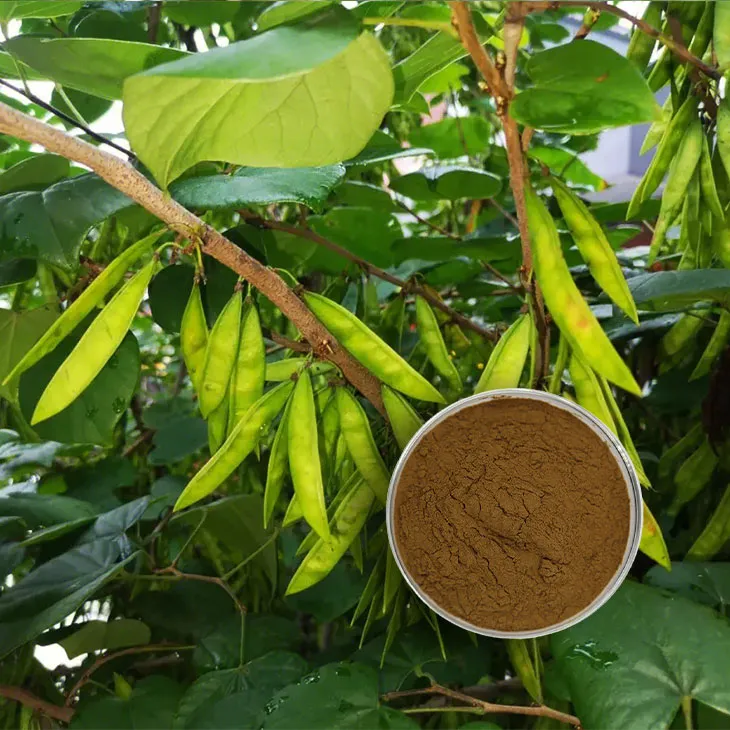- 0086-571-85302990
- sales@greenskybio.com
The Future of Saponin Extraction: Innovations and Advancements
2024-08-17

1. Introduction
Saponins are a diverse group of natural compounds found in a wide range of plants. They have attracted significant attention due to their various biological activities, including anti - inflammatory, antioxidant, and anticancer properties. Saponin Extraction has long been an area of research, but recent years have witnessed a rapid evolution in this field. This article delves into the future of Saponin Extraction, exploring the emerging trends that are set to transform the way saponins are extracted and utilized.

2. Sustainable Extraction Practices
2.1. Green Solvents
Traditionally, the extraction of saponins has often relied on organic solvents that may be harmful to the environment and human health. However, the future is leaning towards the use of green solvents. These solvents are generally derived from renewable resources and have a lower environmental impact. For example, supercritical fluids such as supercritical carbon dioxide (scCO₂) are emerging as promising alternatives. scCO₂ has the advantage of being non - toxic, non - flammable, and easily removable from the extract. It can also selectively extract saponins, leaving behind unwanted impurities. Another example is ionic liquids, which have tunable properties that can be adjusted to optimize Saponin Extraction while minimizing solvent waste.
2.2. Plant - Based Biorefinery Approach
The concept of a plant - based biorefinery is gaining momentum in saponin extraction. Instead of simply extracting saponins and discarding the rest of the plant material, a biorefinery approach aims to utilize all components of the plant. This is not only more sustainable but also economically viable. For instance, after saponin extraction, the remaining plant biomass can be used for the production of biofuels, bioplastics, or other high - value products. By integrating saponin extraction into a comprehensive biorefinery process, the overall efficiency of plant utilization is maximized, reducing waste and environmental impact.
2.3. Conservation of Endangered Plant Sources
Many plants that are rich sources of saponins are endangered due to over - harvesting. In the future, there will be a greater emphasis on conserving these precious plant resources. This could involve the development of sustainable harvesting practices, such as selective harvesting or cultivation in protected areas. Additionally, research efforts may focus on finding alternative plant sources of saponins or developing synthetic methods to mimic the saponin structures, reducing the pressure on wild plant populations.

3. Integration of Artificial Intelligence (AI) in Extraction Processes
3.1. Optimization of Extraction Parameters
AI - powered algorithms can analyze a vast amount of data related to saponin extraction parameters, such as temperature, pressure, solvent - to - material ratio, and extraction time. By doing so, they can predict the optimal conditions for maximum saponin yield and quality. For example, machine learning models can be trained on historical extraction data from different plant sources. These models can then be used to recommend the most suitable extraction parameters for a new batch of plants, saving time and resources in the experimental process.
3.2. Quality Control and Predictive Analytics
AI can also play a crucial role in quality control during saponin extraction. Spectroscopic techniques, such as infrared spectroscopy and nuclear magnetic resonance (NMR), generate complex data that can be difficult to interpret manually. AI - based algorithms can analyze these spectroscopic data to quickly and accurately determine the purity and quality of the saponin extract. Moreover, predictive analytics using AI can forecast potential issues in the extraction process, such as equipment failure or deviation from the desired saponin profile. This allows for proactive measures to be taken to ensure a smooth and high - quality extraction process.
3.3. Process Automation
Automation is another area where AI can have a significant impact on saponin extraction. Robotic systems can be programmed to perform repetitive extraction tasks, such as sample preparation and solvent addition, with high precision. These robotic systems can be integrated with AI - controlled sensors that monitor the extraction process in real - time. Based on the sensor data, the AI can adjust the extraction parameters or trigger alerts in case of any anomalies. This level of automation not only improves the efficiency of the extraction process but also reduces the potential for human error.

4. Exploration of Saponin's Untapped Properties
4.1. Pharmaceutical Applications
While some saponin - based drugs are already in use, there is still much to discover about their pharmaceutical potential. Future research may focus on developing saponin - based drugs for new therapeutic targets, such as neurodegenerative diseases or autoimmune disorders. Saponins have shown promising activity in modulating the immune system, and this property could be harnessed to develop novel immunomodulatory drugs. Additionally, the ability of saponins to cross the blood - brain barrier may open up new avenues for the treatment of brain - related disorders.
4.2. Cosmetic and Skincare Innovations
In the cosmetic industry, saponins are known for their foaming and cleansing properties. However, their potential goes beyond traditional uses. Future developments may see saponins being used as active ingredients in anti - aging creams, due to their antioxidant and collagen - promoting properties. They may also be incorporated into sunscreens as natural UV absorbers or used in haircare products to improve hair strength and shine. Research into the molecular mechanisms of saponins in skin and hair health will drive these cosmetic and skincare innovations.
4.3. Agricultural and Food Applications
Saponins have been shown to have insecticidal and fungicidal properties, which could be exploited in agriculture. In the future, saponin - based pesticides and fungicides may be developed as more environmentally friendly alternatives to synthetic chemicals. In the food industry, saponins could be used as natural preservatives or functional ingredients. For example, they may help in reducing cholesterol levels in food products or enhancing the nutritional value of certain foods.

5. Conclusion
The future of saponin extraction is filled with exciting possibilities. Sustainable extraction practices will not only protect the environment but also ensure the long - term availability of saponin - rich plants. The integration of AI in extraction processes will bring about greater efficiency, quality control, and automation. Moreover, the exploration of saponin's untapped properties will open up new applications in pharmaceuticals, cosmetics, agriculture, and food. As research in these areas continues to progress, we can expect to see a significant transformation in the saponin extraction industry, leading to the development of more sustainable, efficient, and innovative products and processes.
FAQ:
What are the sustainable extraction practices in saponin extraction?
Sustainable extraction practices in saponin extraction may include using renewable energy sources during the extraction process. For example, solar - powered equipment can be employed to reduce reliance on non - renewable energy. Another aspect is the proper management of raw materials. Instead of over - harvesting plants that contain saponins, sustainable cultivation methods can be implemented. This ensures a continuous supply of raw materials without depleting natural resources. Also, reducing waste generation during extraction and promoting recycling of extraction solvents are important sustainable practices.
How can artificial intelligence be integrated into saponin extraction processes?
Artificial intelligence can be integrated into saponin extraction processes in several ways. AI can be used for process optimization. It can analyze large amounts of data related to extraction conditions such as temperature, pressure, and solvent concentration to determine the most efficient extraction parameters. AI - powered sensors can also be used to monitor the quality of the raw materials in real - time. For instance, they can detect the saponin content in plants accurately, helping to select the best raw materials for extraction. Additionally, AI can predict the yield of saponin extraction based on historical data and current input variables, enabling better planning and resource allocation in the extraction facility.
What are the untapped properties of saponin that are being explored?
Some of the untapped properties of saponin that are currently being explored include its potential in the field of medicine. Saponins may have anti - cancer properties that are yet to be fully understood and harnessed. In the cosmetic industry, their antioxidant and skin - protecting properties are being investigated further. Saponins may also have applications in the food industry as natural preservatives or additives. Their potential in environmental protection, such as in water purification due to their surfactant - like properties, is another area of exploration.
How will these advancements in saponin extraction impact the industry?
These advancements in saponin extraction will have a significant impact on the industry. The use of sustainable extraction practices will make the industry more environmentally friendly and compliant with regulations, which can enhance its public image. Integration of artificial intelligence will increase productivity and efficiency, reducing costs and increasing the quality of the extracted saponins. The exploration of untapped properties will open up new markets for saponin - based products. For example, if saponins are proven to be effective as anti - cancer agents, it will create a new segment in the pharmaceutical industry. Overall, these advancements will drive growth and innovation in the saponin extraction industry.
What challenges might be faced in implementing these new trends in saponin extraction?
One of the main challenges in implementing these new trends in saponin extraction is the cost. For example, integrating artificial intelligence systems requires significant investment in technology and training of personnel. In terms of sustainable extraction, setting up new cultivation methods or using renewable energy sources may also be costly in the short - term. Another challenge is the lack of skilled personnel. To operate AI - integrated extraction processes and manage sustainable extraction practices, specialized knowledge is required. There may also be regulatory hurdles as new extraction methods and products need to meet safety and quality standards.
Related literature
- Advances in Saponin Extraction Technology"
- "Sustainable Saponin Extraction: A Review"
- "The Role of Artificial Intelligence in Natural Product Extraction: Focus on Saponin"
- "Untapped Potential of Saponins: New Frontiers in Research"
- ▶ Hesperidin
- ▶ citrus bioflavonoids
- ▶ plant extract
- ▶ lycopene
- ▶ Diosmin
- ▶ Grape seed extract
- ▶ Sea buckthorn Juice Powder
- ▶ Beetroot powder
- ▶ Hops Extract
- ▶ Artichoke Extract
- ▶ Reishi mushroom extract
- ▶ Astaxanthin
- ▶ Green Tea Extract
- ▶ Curcumin Extract
- ▶ Horse Chestnut Extract
- ▶ Other Problems
- ▶ Boswellia Serrata Extract
- ▶ Resveratrol Extract
- ▶ Marigold Extract
- ▶ Grape Leaf Extract
- ▶ blog3
- ▶ blog4
- ▶ blog5
-
Peppermint Extract Powder
2024-08-17
-
Rose Hip Extract
2024-08-17
-
Camu Camu Extract
2024-08-17
-
Motherwort Extract
2024-08-17
-
American Ginseng Root Extract
2024-08-17
-
Okra Extract
2024-08-17
-
Purple Sweet Potato Extract
2024-08-17
-
Cactus Extract
2024-08-17
-
Sophora Japonica Flower Extract
2024-08-17
-
Artichoke Leaf Extract
2024-08-17





















